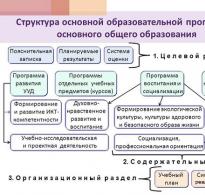How to solve inequalities with 2 variables. Lesson summary "solving systems of inequalities with two variables." with two variables
Subject: Equations and inequalities. Systems of equations and inequalities
Lesson:Equations and inequalities with two variables
Let us consider in general terms an equation and an inequality with two variables.
Equation with two variables;
Inequality with two variables, the inequality sign can be anything;
Here x and y are variables, p is an expression that depends on them
A pair of numbers () is called a partial solution of such an equation or inequality if, when substituting this pair into the expression, we obtain the correct equation or inequality, respectively.
The task is to find or depict on a plane the set of all solutions. You can paraphrase this task - find the locus of points (GLP), construct a graph of an equation or inequality.
Example 1 - solve equation and inequality:
In other words, the task involves finding the GMT.
Let's consider the solution to the equation. In this case, the value of the variable x can be any, so we have:
Obviously, the solution to the equation is the set of points forming a straight line

Rice. 1. Equation Graph Example 1
The solutions to a given equation are, in particular, the points (-1; 0), (0; 1), (x 0, x 0 +1)
The solution to the given inequality is a half-plane located above the line, including the line itself (see Figure 1). Indeed, if we take any point x 0 on the line, then we have the equality . If we take a point in a half-plane above a line, we have . If we take a point in the half-plane under the line, then it will not satisfy our inequality: .
Now consider the problem with a circle and a circle.
Example 2 - solve equation and inequality:
We know that the given equation is the equation of a circle with center at the origin and radius 1.

Rice. 2. Illustration for example 2
At an arbitrary point x 0, the equation has two solutions: (x 0; y 0) and (x 0; -y 0).
The solution to a given inequality is a set of points located inside the circle, not taking into account the circle itself (see Figure 2).
Let's consider an equation with modules.
Example 3 - solve the equation:
In this case, it would be possible to expand the modules, but we will consider the specifics of the equation. It is easy to see that the graph of this equation is symmetrical about both axes. Then if the point (x 0 ; y 0) is a solution, then the point (x 0 ; -y 0) is also a solution, the points (-x 0 ; y 0) and (-x 0 ; -y 0) are also a solution .
Thus, it is enough to find a solution where both variables are non-negative and take symmetry about the axes:

Rice. 3. Illustration for example 3
So, as we see, the solution to the equation is a square.
Let's look at the so-called area method using a specific example.
Example 4 - depict the set of solutions to the inequality:
According to the method of domains, first of all we consider the function on the left side if there is zero on the right. This is a function of two variables:
![]()
Similar to the method of intervals, we temporarily move away from the inequality and study the features and properties of the composed function.
ODZ: that means the x axis is being punctured.
Now we indicate that the function is equal to zero when the numerator of the fraction is equal to zero, we have:
We build a graph of the function.

Rice. 4. Graph of the function, taking into account the ODZ
Now consider the areas of constant sign of the function; they are formed by a straight line and a broken line. inside the broken line there is area D 1. Between a segment of a broken line and a straight line - area D 2, below the line - area D 3, between a segment of a broken line and a straight line - area D 4
In each of the selected areas, the function retains its sign, which means it is enough to check an arbitrary test point in each area.
In the area we take the point (0;1). We have:
![]()
In the area we take the point (10;1). We have:
![]()
Thus, the entire region is negative and does not satisfy the given inequality.
In the area, take the point (0;-5). We have:
![]()
Thus, the entire region is positive and satisfies the given inequality.
1. Inequalities with two variables. Methods for solving a system of two inequalities with two variables: analytical method and graphical method.
2. Systems of two inequalities with two variables: recording the result of the solution.
3. Sets of inequalities with two variables.
INEQUALITIES AND SYSTEMS OF INEQUALITIES WITH TWO VARIABLES. Predicate of the form f₁(x, y)>< f 2 (х, у), хÎХ, уÎ У, где f₁(х, у) и f 2 (х, у) - expressions with variables x and y defined on the set XxY are called inequality with two variables (with two unknowns) x and y. It is clear that any inequality of the form with two variables can be written in the form f(x, y) > 0, ХОХ, уО U. Solving the inequality with two variables is a pair of variable values that converts an inequality into a true numerical inequality. It is known that a pair of real numbers (x, y) uniquely determines a point on the coordinate plane. This makes it possible to depict solutions to inequalities or systems of inequalities with two variables geometrically, in the form of a certain set of points on the coordinate plane. If Eq.
f(x, y)= 0 defines a certain line on the coordinate plane, then the set of points of the plane that do not lie on this line consists of a finite number of regions C₁, C 2,..., S p(Fig. 17.8). In each of the areas C, the function f(x, y) is different from zero, because points at which f(x, y)= 0 belong to the boundaries of these areas.
Solution. Let's transform the inequality to the form x > y 2 + 2y - 3. Let's construct a parabola on the coordinate plane X= y 2 + 2y - 3. It will divide the plane into two regions G₁ and G 2 (Fig. 17.9). Since the abscissa of any point lying to the right of the parabola X= y 2 + 2y- 3, greater than the abscissa of a point that has the same ordinate, but lies on a parabola, etc. inequality x>y g + 2y -3 is not strict, then the geometric representation of solutions to this inequality will be the set of points of the plane lying on the parabola X= at 2+ 2у - 3 and to the right of it (Fig. 17.9).

| Rice. 17.9 |
Rice. 17.10
Example 17.15. Draw on the coordinate plane the set of solutions to the system of inequalities
y > 0,
xy > 5,
x + y<6.
Solution. A geometric representation of the solution to the system of inequalities x > 0, y > 0 is the set of points of the first coordinate angle. Geometric representation of solutions to inequalities x + y< 6 or at< 6 - X is the set of points lying below the line and on the line itself, serving as the graph of the function y = 6 - X. Geometric representation of solutions to inequalities xy > 5 or, because X> 0 inequalities y > 5/x is the set of points lying above the branch of the hyperbola that serves as the graph of the function y = 5/x. As a result, we obtain a set of points of the coordinate plane lying in the first coordinate angle below the straight line, which serves as the graph of the function y = 6 - x, and above the branch of the hyperbola, which serves as the graph of the function y = 5x(Fig. 17.10).
Chapter III. NATURAL NUMBERS AND ZERO
, and even more so systems of inequalities with two variables, it seems quite a difficult task. However, there is a simple algorithm that helps solve seemingly very complex problems of this kind easily and without much effort. Let's try to figure it out.
Let us have an inequality with two variables of one of the following types:
y > f(x); y ≥ f(x); y< f(x); y ≤ f(x).
To depict the set of solutions to such an inequality on the coordinate plane, proceed as follows:
- We build a graph of the function y = f(x), which divides the plane into two regions.
- We select any of the resulting areas and consider an arbitrary point in it. We check the feasibility of the original inequality for this point. If the test results in a correct numerical inequality, then we conclude that the original inequality is satisfied in the entire region to which the selected point belongs. Thus, the set of solutions to the inequality is the region to which the selected point belongs. If the result of the check is an incorrect numerical inequality, then the set of solutions to the inequality will be the second region to which the selected point does not belong.
- If the inequality is strict, then the boundaries of the region, that is, the points of the graph of the function y = f(x), are not included in the set of solutions and the boundary is depicted with a dotted line. If the inequality is not strict, then the boundaries of the region, that is, the points of the graph of the function y = f(x), are included in the set of solutions to this inequality and the boundary in this case is depicted as a solid line. Now let's look at several problems on this topic.
Task 1.
What set of points is given by the inequality x · y ≤ 4?
Solution.
1) We build a graph of the equation x · y = 4. To do this, we first transform it. Obviously, x in this case does not turn to 0, since otherwise we would have 0 · y = 4, which is incorrect. This means we can divide our equation by x. We get: y = 4/x. The graph of this function is a hyperbola. It divides the entire plane into two regions: the one between the two branches of the hyperbola and the one outside them.
2) Let’s select an arbitrary point from the first region, let it be point (4; 2). Let's check the inequality: 4 · 2 ≤ 4 – false.
This means that the points of this region do not satisfy the original inequality. Then we can conclude that the set of solutions to the inequality will be the second region to which the selected point does not belong.
3) Since the inequality is not strict, we draw the boundary points, that is, the points of the graph of the function y=4/x, with a solid line.
Let us paint the set of points that defines the original inequality in yellow (Fig. 1).
Task 2.
Draw the area defined on the coordinate plane by the system
Solution.
To begin with, we build graphs of the following functions (Fig. 2):
y = x 2 + 2 – parabola,
y + x = 1 – straight line
x 2 + y 2 = 9 – circle.

Now let's look at each inequality separately.
1) y > x 2 + 2.
We take the point (0; 5), which lies above the graph of the function. Let's check the inequality: 5 > 0 2 + 2 – true.
Consequently, all points lying above the given parabola y = x 2 + 2 satisfy the first inequality of the system. Let's paint them yellow.
2) y + x > 1.
We take the point (0; 3), which lies above the graph of the function. Let's check the inequality: 3 + 0 > 1 – true.
Consequently, all points lying above the straight line y + x = 1 satisfy the second inequality of the system. Let's paint them with green shading.
3) x 2 + y 2 ≤ 9.
We take the point (0; -4), which lies outside the circle x 2 + y 2 = 9. We check the inequality: 0 2 + (-4) 2 ≤ 9 – incorrect.
Consequently, all points lying outside the circle x 2 + y 2 = 9 do not satisfy the third inequality of the system. Then we can conclude that all points lying inside the circle x 2 + y 2 = 9 satisfy the third inequality of the system. Let's paint them with purple shading.

Do not forget that if the inequality is strict, then the corresponding boundary line should be drawn with a dotted line. We get the following picture (Fig. 3).

The search area is the area where all three colored areas intersect with each other (Fig. 4).
Questions for notes

Write an inequality whose solution is a circle and points inside the circle: 
Find the points that solve the inequality:
1) (6;10)
2) (-12;0)
3) (8;9)
4) (9;7)
5) (-12;12)
Let f(x,y) And g(x, y)- two expressions with variables X And at and scope X. Then inequalities of the form f(x, y) > g(x, y) or f(x, y) < g(x, y) called inequality with two variables .
Meaning of Variables x, y from many X, at which the inequality turns into a true numerical inequality, it is called decision and is designated (x, y). Solve inequality - this means finding many such pairs.
If each pair of numbers (x, y) from the set of solutions to the inequality, match the point M(x, y), we obtain the set of points on the plane specified by this inequality. He is called graph of this inequality . The graph of an inequality is usually an area on a plane.
To depict the set of solutions to the inequality f(x, y) > g(x, y), proceed as follows. First, replace the inequality sign with an equal sign and find a line that has the equation f(x,y) = g(x,y). This line divides the plane into several parts. After this, it is enough to take one point in each part and check whether the inequality is satisfied at this point f(x, y) > g(x, y). If it is executed at this point, then it will be executed in the entire part where this point lies. Combining such parts, we obtain many solutions.
Task. y > x.
Solution. First, we replace the inequality sign with an equal sign and construct a line in a rectangular coordinate system that has the equation y = x.
This line divides the plane into two parts. After this, take one point in each part and check whether the inequality is satisfied at this point y > x.
Task. Solve graphically the inequality
X 2 + at 2 £25.
|

Let two inequalities be given f 1(x, y) > g 1(x, y) And f 2(x, y) > g 2(x, y).
Systems of sets of inequalities with two variables
System of inequalities is yourself conjunction of these inequalities. System solution is every meaning (x, y), which turns each of the inequalities into a true numerical inequality. Many solutions systems inequalities is the intersection of sets of solutions to inequalities that form a given system.
Set of inequalities is yourself disjunction of these inequalities Set solution is every meaning (x, y), which converts at least one of the set of inequalities into a true numerical inequality. Many solutions totality is a union of sets of solutions to inequalities that form a set.
Task. Solve graphically the system of inequalities 
 Solution. y = x And X 2 + at 2 = 25. We solve each inequality of the system.
Solution. y = x And X 2 + at 2 = 25. We solve each inequality of the system.
The graph of the system will be the set of points on the plane that are the intersection (double hatching) of the sets of solutions to the first and second inequalities.
Task. Solve graphically a set of inequalities 

Exercises for independent work
1. Solve graphically the inequalities: a) at> 2x; b) at< 2x + 3;
V) x 2+ y 2 > 9; G) x 2+ y 2 £4.
2. Solve graphically the systems of inequalities:
a) b) 
The video lesson “Systems of inequalities with two variables” contains visual educational material on this topic. The lesson includes consideration of the concept of solving a system of inequalities with two variables, examples of solving such systems graphically. The purpose of this video lesson is to develop students’ ability to solve systems of inequalities with two variables graphically, to facilitate understanding of the process of finding solutions to such systems and memorizing the solution method.
Each description of the solution is accompanied by drawings that display the solution to the problem on the coordinate plane. Such figures clearly show the features of constructing graphs and the location of points corresponding to the solution. All important details and concepts are highlighted using color. Thus, a video lesson is a convenient tool for solving teacher problems in the classroom and frees the teacher from presenting a standard block of material for individual work with students.
The video lesson begins by introducing the topic and considering an example of finding solutions to a system consisting of inequalities x<=y 2 и у<х+3. Примером точки, координаты которой удовлетворяют условиям обеих неравенств, является (1;3). Отмечается, что, так как данная пара значений является решением обоих неравенств, то она является одним из множества решений. А все множество решений будет охватывать пересечение множеств, которые являются решениями каждого из неравенств. Данный вывод выделен в рамку для запоминания и указания на его важность. Далее указывается, что множество решений на координатной плоскости представляет собой множество точек, которые являются общими для множеств, представляющих решения каждого из неравенств.

Understanding of the conclusions drawn about solving a system of inequalities is strengthened by considering examples. The solution to the system of inequalities x 2 + y 2 is considered first<=9 и x+y>=2. Obviously, solutions to the first inequality on the coordinate plane include the circle x 2 + y 2 = 9 and the region inside it. This area in the figure is filled with horizontal shading. The set of solutions to the inequality x+y>=2 includes the line x+y=2 and the half-plane located above. This area is also indicated on the plane by strokes in a different direction. Now we can determine the intersection of two solution sets in the figure. It is contained in a circle segment x 2 + y 2<=9, который покрыт штриховкой полуплоскости x+y>=2.
Next, we analyze the solution to the system of linear inequalities y>=x-3 and y>=-2x+4. In the figure, next to the task condition, a coordinate plane is constructed. A straight line is constructed on it, corresponding to the solutions of the equation y=x-3. The solution area for the inequality y>=x-3 will be the area located above this line. She is shaded. The set of solutions to the second inequality is located above the line y=-2x+4. This straight line is also constructed on the same coordinate plane and the solution area is hatched. The intersection of two sets is the angle constructed by two straight lines, together with its interior region. The solution area of the system of inequalities is filled with double shading.

When considering the third example, the case is described when the graphs of the equations corresponding to the inequalities of the system are parallel lines. It is necessary to solve the system of inequalities y<=3x+1 и y>=3x-2. A straight line is constructed on the coordinate plane corresponding to the equation y=3x+1. Range of values corresponding to solutions of the inequality y<=3x+1, лежит ниже данной прямой. Множество решений второго неравенства лежит выше прямой y=3x-2. При построении отмечается, что данные прямые параллельны. Область, являющаяся пересечением двух множеств решений, представляет собой полосу между данными прямыми.

The video lesson “Systems of Inequalities with Two Variables” can be used as a visual aid in a lesson at school or replace the teacher’s explanation when studying the material on your own. A detailed, understandable explanation of solving systems of inequalities on the coordinate plane can help present material during distance learning.





